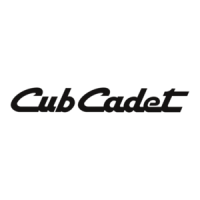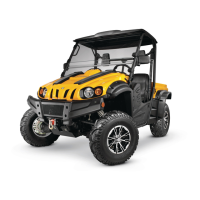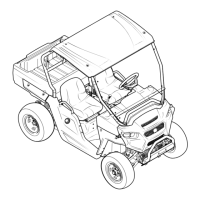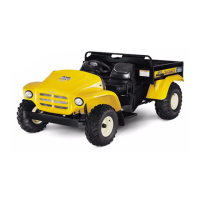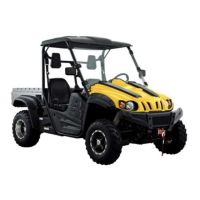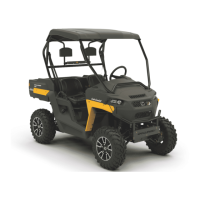18 Section 5— Maintenance & adjuStMentS
1. Connect positive (+) jumper cable to booster battery
positive (+) post (A). See Figure 5-7.
Jumper Cables
Booster BatteryDisabled Battery
D
C
B
A
Figure 5-7
2. Connect the other end of positive (+) jumper cable to the
disabled vehicle battery positive (+) post (B).
3. Connect negative (-) jumper cable to booster battery
negative (-) post (C).
4. Connect the other end (D) of negative (-) jumper cable to
a metal part of the disabled machine frame away from
battery.
5. Start the engine of the disabled machine and run machine
for several minutes.
6. Carefully disconnect the jumper cables in the exact reverse
order: negative cable first and then the positive cable.
IMPORTANT: Alternator will not charge unless battery has
minimum of 11 volts. Unit will not run if battery voltage is
be lo w 11.
Charging Battery
WARNING: Charge battery in a well ventilated area
and keep away from an open flame or pilot light as
on a water heater, space heater, furnace, clothes
dryer or other gas appliances.
If the vehicle has not been put into use for an extended period of
time, charge the battery with an automotive type 12-volt charger
for a minimum of one hour at six amps.
Tire Pressure
WARNING: Explosive separation of tire and rim
parts is possible when they are serviced incorrectly.
Do not stand in front or over tire assembly when
inflating.
The recommended operating tire pressure is approximately
14-18 psi for all tires. Overinflating above recommended tire
pressure can reduce the life of the tire. Check tire pressure before
driving the vehicle.
Operator Protective Structure (OPS)
Periodically (at least every six months) visually inspect the OPS
and seat belts need to be inspected for damage and proper
function before each use or daily. Replace belt assembly if any
damaged is found.for damage and loose fasteners. If damage is
noted, contact your Cub Cadet dealer.
If an accident has occurred which may have damaged the OPS,
have the OPS thoroughly inspected by your Cub Cadet dealer.
WARNING: To ensure the structural integrity of the
OPS to provide operator protection, do not attempt
to straighten or weld the OPS. A damaged OPS
should be replaced.
If the OPS is removed for any reason, make sure the proper
hardware is used to reinstall it, and that the recommended
torque values are applied to the fasteners.
If you are not installing new bolts when replacing or reinstalling
the OPS, apply Loctite ® 242 to the threads of the bolts that were
removed. Torque the bolts to 50 to 55 ft. lbs.
Front and Rear Shocks
Inspect the front and rear shocks every 100 hours or once a year
for oil leakage. See Figure 5-8. If excessive oil leakage appears,
have shocks repaired or replaced by your local Cub Cadet dealer.
CV Boots
Inspect CV boots (two on each CV axle, eight total) for tears every
50 hours. See Figure 5-8. If tears or excessive wear appear, have
boots replaced by your local Cub Cadet dealer.
Figure 5-8
Ball Joints
Inspect the upper and lower front A-arm ball joints on each side
of the vehicle and the two tie rod ends for wear every 100 hours
or once a year. See Figure 5-9. If excessive wear appears, have ball
joints or tie rod ends replaced by your local Cub Cadet dealer.
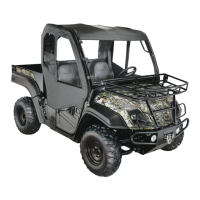
